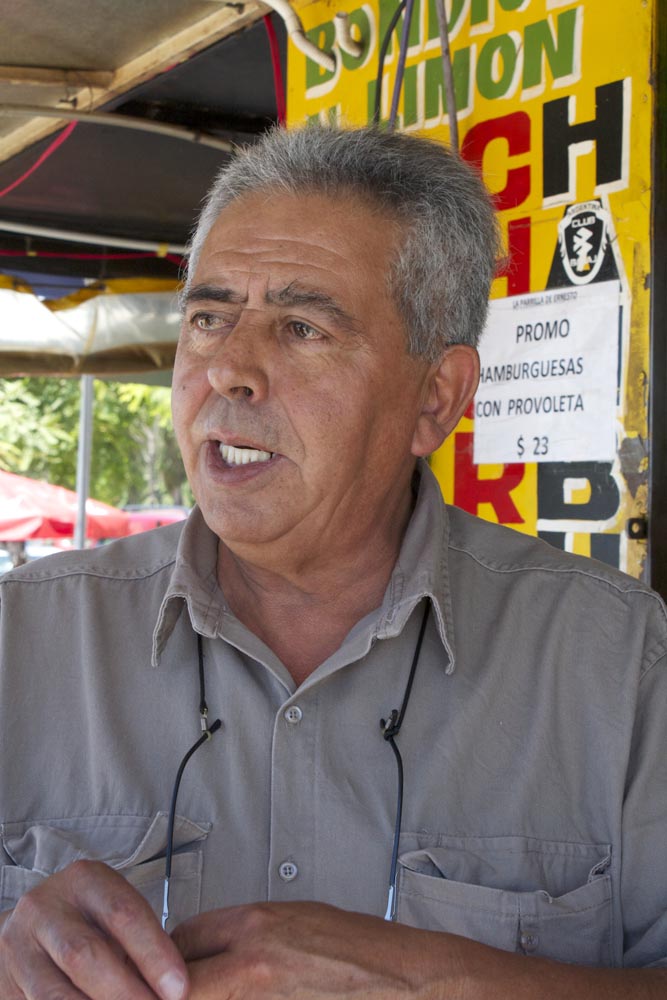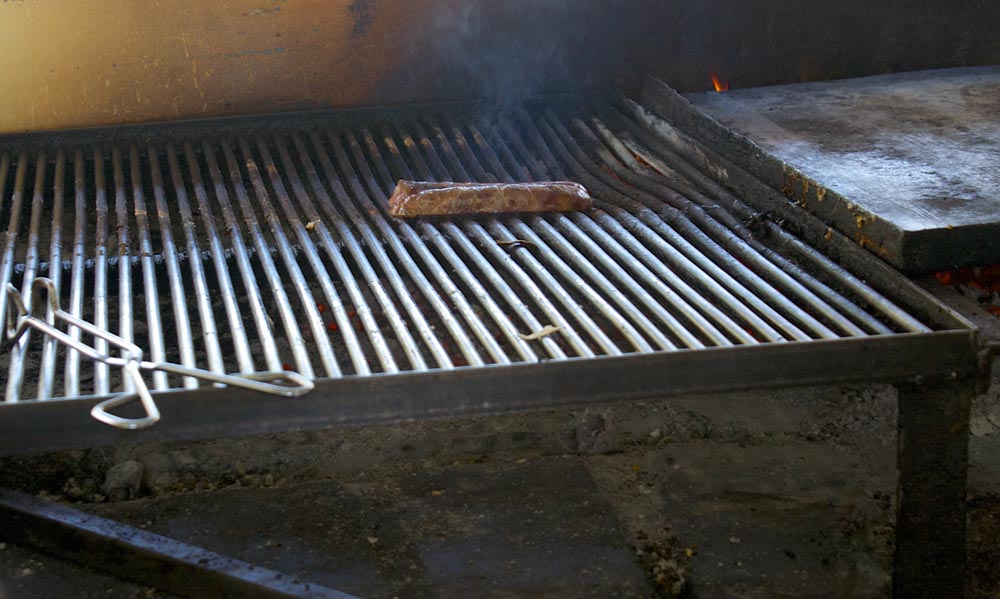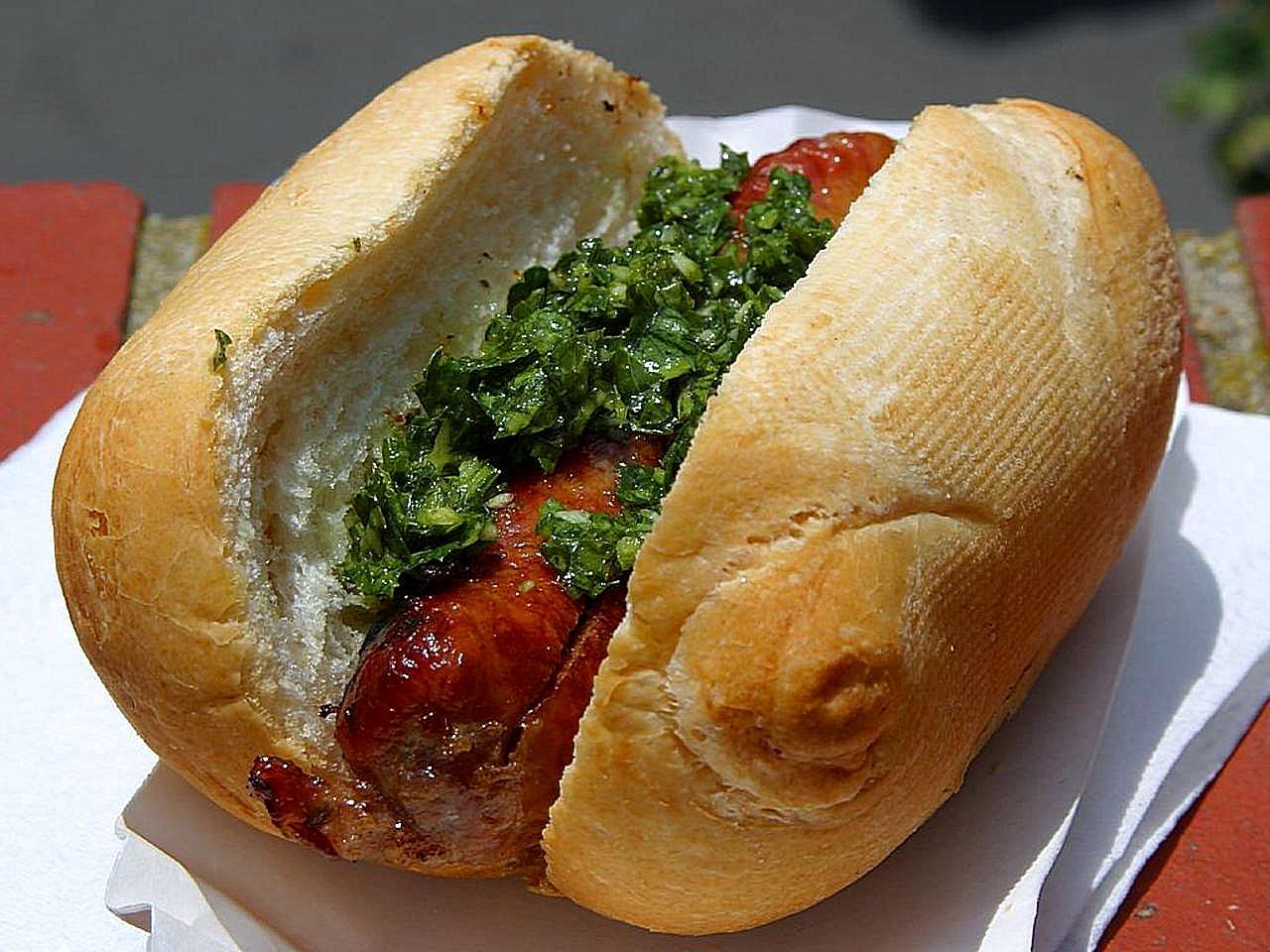Pedro and his son, Ernesto, have sold choripán sandwiches in Buenos Aires every day for seven years.
Pedro Molina’s white teeth reflect the Argentinian sun, making a steady gaze into his eyes almost unbearable. For some reason, his smile reveals only his lower teeth, gleaming and even. Sitting in Buenos Aires under one of the umbrellas that shade the tables surrounding his stand, Pedro speaks with a low, soft voice as he describes his life as a vendor of choripán, a combination of chorizo and pan (bread), the two main ingredients of the classic Argentinian sandwich. Pedro flashes his smile throughout our conversation, revealing that row of bright white teeth every time.

“This is a man who shows up for work for reasons other than grilling sausages.”
His bright red and yellow choripán stand, a parilla or grill, bears his son’s name, Ernesto. They have worked side by side, day after day, for at least seven years. Families, hungover teens and grandmothers who are walking along the broad sidewalk that borders the Buenos Aires Ecological Reserve along the Rio de la Plata buy their Argentinian chorizo sandwiches here.
Pedro describes his family in San Juan province, a rocky section of Argentina located along the western border with Chile. They raised pigs that sometimes wandered through the house. Since he was six years old, Pedro worked alongside his father, fattening their pigs so they could make sausage, and he grew up grilling chorizo. His father was an artisan of sorts, fabricating leather harnesses for horses. He was also an owner of a fruit business and came from a family that produced a long line of cooks. Before setting up his choripán stand, Pedro did just about everything “except being a thief.” He sold cars, fruit, and vegetables, and he worked in a family-run leather store. Seven years ago, those memories sparked his interest in starting a sandwich stand selling choripán.
Now, in his mid-60s, Pedro reflects upon the many jobs that came before his beloved choripán stand. He speaks earnestly about the importance of work to a sense of wellbeing. And he has strong opinions about work, an activity that he says “dignifies the human soul,” expressing what he describes as man’s innate character of active love. This is a man who shows up for work for reasons other than grilling sausages.
Pedro glances back and forth between my notebook, where I’m furiously writing, and his son, who is frantically setting up the stall for the day’s business. Pedro compliments Ernesto’s mastery of the grill, but he is ambivalent about any plan to have his son take over the business. Raising both hands to the sky, he reveals those white teeth, smiles and sighs as he says that fate will determine what his son does in the future. Perhaps Pedro holds the hope of a family succession plan, but all indications that day were that he is content to leave the decision up to Ernesto, who at this moment is grilling up a mountain of fresh chorizo for the day’s lunch rush.

But Pedro has no desire to hand over his business just yet. He wants to continue to work, and judging from his late arrival to our interview, he’s in the thick of day-to-day operations of his choripán stand. He was an hour late for our meeting, a large man arriving in a small car, hurriedly unloading a plastic bag of pork chorizo that had been stored in his home refrigerator after that week’s heat wave caused a power outage in the city.
Pedro is getting impatient with all the questions about how his business worked and wanted to know why we hadn’t talked more about the choripán sandwiches he sells to his customers. Most of his customers are tourists who don’t buy the choripán but instead consume dozens of hamburgers and other pork and beef sandwiches such as bandiolas, spicy meat sandwiches made of pork or chicken. He sells about forty choripáns a day, and more on weekends. But Pedro is genuinely disappointed that we hadn’t spent most of our interview talking about his choripán sandwiches.
Unable to deflect his invitation, I ask how he makes choripán. With those blazing white teeth on display, he invites me to sidle up alongside Ernesto as his son cooks a chorizo sausage, slicing it open so that it cooks evenly and flat against the hot grill. The smell of sausage and spices fills the small space inside the stand, making it nearly impossible to suppress the desire for a bite of the grilled chorizo. When the sausage is glazed with its own grease, Ernesto gingerly lays it inside a sandwich roll that is similar in taste and texture to a French baguette.
“The smell of sausage and spices fills the small space inside the stand, making it nearly impossible to suppress the desire for a bite of the grilled chorizo.”
Ernesto insists that the classic choripán, his preference, is just chorizo, chimichurri sauce and a combination of oil, vinegar, oregano, cumin, parsley, garlic, red pepper and fennel. He’s wild about oregano, but he provides a table for his customers that satisfies their desire for mayonnaise, mustard, lettuce, tomato and other spicy sauces —all dismissed by Pedro with a brief wave of his hand as unnecessary embellishments for the humble, grilled chorizo nestled in the slightly warmed, soft white bun.
His life and the lives of those he works with mingle in the public park where his stand sits at the end of the paved, tree-lined walkway. The choripán stalls along the walkway are open twenty-four hours a day, every day. When we arrived at 10:00 a.m., all the stall owners were cleaning the grills, stocking new charcoal and taking deliveries of soft drinks, paper napkins, onions and meat. The choripán stalls are kept open with continual deliveries of supplies, people and customers.
“You can imagine a subculture of choripán stall workers whose families have grown up living in these buses, eating grilled meat, raising families, playing music, and cobbling together a work/life existence that keeps choripán coming night and day.”
Lined up along the curb near the stalls are several repainted, beat-up, old buses in all sizes and stages of dilapidation. Stall workers, still seemingly sleepwalking, wander in and out of the buses where they sleep, from time to time. You can imagine a subculture of choripán stall workers whose families have grown up living in these buses, eating grilled meat, raising families, playing music, somehow cobbling together a work/life existence that keeps choripán coming night and day.
Pedro wraps the freshly made choripán and hands it to me with this beefy but manicured hands. With his reading glasses swinging back and forth around his neck, he turns back to the grill, ready to greet the lunch crowd as they emerge from the neighboring high rises. Another day selling sandwiches, day after day, twenty-four-hours a day, all year, as in the past seven years, Pedro and his son, Ernesto, greet customers in the bright, hot, Argentinean sunshine.

Author
The same sense of wonder that called Dr. Robyn Metcalfe to run the great deserts of the world has led her to take on the task of mapping our current food supply. A historian, desert distance runner and food futurist with a lifelong hunger to take on irrational challenges, Robyn Metcalfe marvels at what it takes to simply create a peanut butter and jelly sandwich.